That moment right after sign-up? That’s the subscriber honeymoon period. It’s short, it’s powerful, and it’s when your new subscriber is paying attention. They’re curious. They’re open. They’re literally waiting to see what you’ll say next. And your welcome message, your first impression, can either reward that attention or quietly shut the door on it.
The same idea applies when welcoming a new employee. They’ve said “yes” to your organization, likely after weeks (or months) of interviews, decisions, and excitement. That first onboarding message isn’t just logistics. It’s emotional real estate. It’s your opportunity to affirm their choice, ease their nerves, and set the tone for what working with you will feel like.
Whether you’re writing to a new subscriber or a new team member, the welcome email is more than a formality. It’s a moment. And you only get one shot at it.
Table of Contents
- What is a welcome email?
- The Components of an Impressive Welcome Email
- Examples of Standout Welcome Emails
- Welcome Email Templates
- How to Write a Welcome Email: Step-by-Step
- How to Write an Employee Onboarding Welcome Email: Step-by-Step
What is a welcome email?
A welcome email is the first message a subscriber gets after signing up — your digital handshake. It confirms their subscription, sets expectations, and gives them a quick intro to your brand’s vibe and value. It’s not just polite; it’s prime real estate for making a strong first impression and setting the stage for engagement.
Pro tip: Use HubSpot’s free email marketing software to easily create a high-quality welcome email sequence like the ones featured below.
The Components of an Impressive Welcome Email
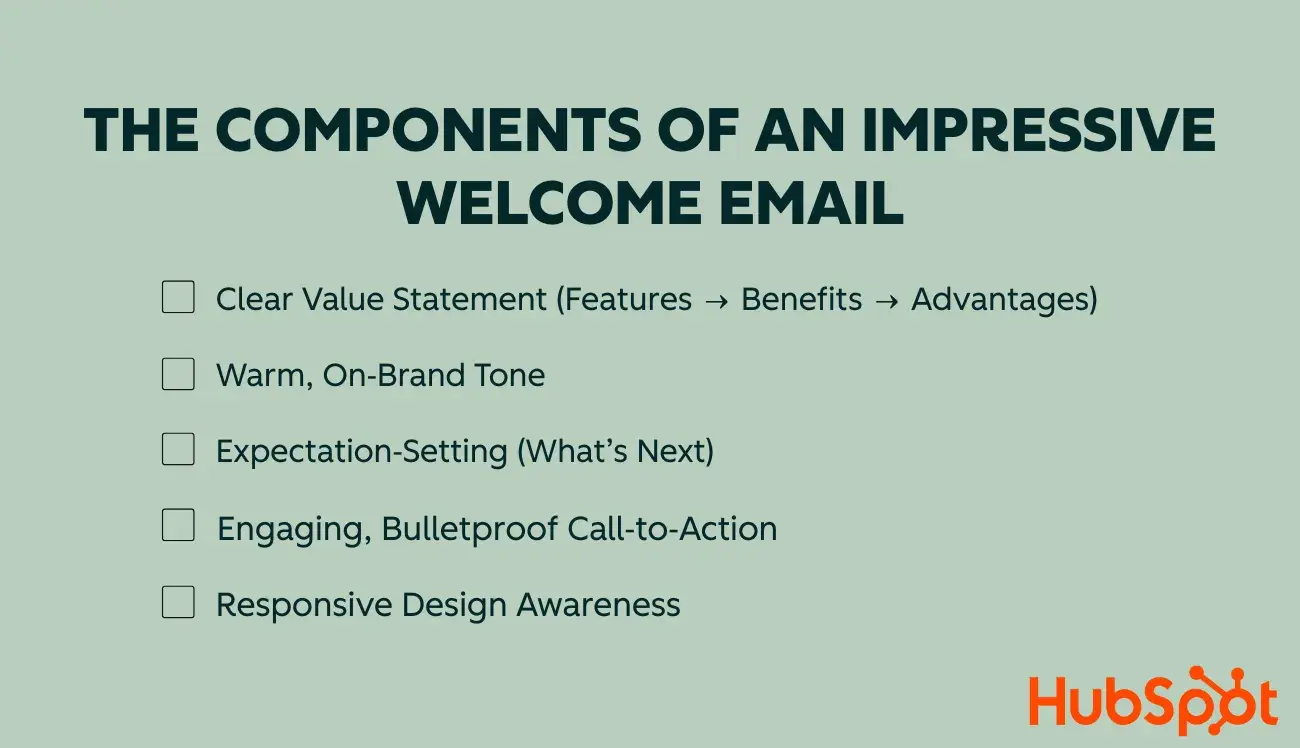
1. Clear Value Statement (Features → Benefits → Advantages)
If you’ve ever clicked unsubscribe after a bland “Thanks for joining” message, you already know the pain of a wasted welcome email. Your first message should do more than wave hello; it should prove your value.
Start with the feature (what they get), follow with the benefit (why it matters), and end with the advantage (why it’s better than other options). This structure isn’t just tidy, it’s persuasive. The goal? Make subscribers feel like they’ve just made a smart decision by joining your list. Because they did.
Pro tip: Use real user language from surveys or reviews when describing the benefit. It keeps things grounded and customer-centered — plus, it’s more likely to resonate.
2. Warm, On‑Brand Tone
No one wants to feel like they just got an automated shrug from a robot. Your welcome email should sound like you: warm, real, and human. Even if your brand skews corporate, this is the time to relax your tie and let your personality peek through. A touch of humor? Yes. A short anecdote or “here’s what drives us”? Even better. The tone should feel like your best salesperson just slid into the inbox with a smile, not a pitch.
Pro tip: Read it out loud before sending. If it sounds like something you’d never say in real life, rewrite it. The inbox has zero tolerance for blandness.
3. Expectation‑Setting (What’s Next)
This is where you get ahead of the “Wait, why am I getting this?” moment. Be explicit: How often will they receive email from you? What kind of content will you send them? When can they expect the next one?
Setting expectations upfront builds trust and reduces unsubscribes, not to mention that it saves you from the wrath of subscribers who feel spammed after two perfectly normal messages. The more transparent you are, the more control the reader feels they have. That’s a good thing.
Pro tip: Use a short bulleted list or a bolded section header like “Here’s what to expect” so even scanners catch it.
4. Engaging, Bulletproof Call‑to‑Action
If your welcome email doesn’t include a clear next step, you’re leaving engagement on the table. Whether it’s reading a blog post, filling out a preference center, or grabbing a freebie, every welcome email should include a single, strong call-to-action (CTA).
Make it prominent, persuasive, and — here’s the kicker — bulletproof. Meaning: Don’t rely on images. Use HTML-styled buttons that still display if images are blocked (which, by the way, they often are).
Pro tip: Treat your CTA like a headline. Make it benefit-driven (“Get your first wellness tip”) instead of directive (“Click here”).
5. Responsive Design Awareness
Your subscribers are reading emails on phones, tablets, and desktops. That welcome email has to look good everywhere. Use fluid layouts, mobile-first coding practices, and test your design on multiple screen sizes. At the very least, make sure fonts are legible and buttons are tappable. Because nothing kills a first impression like a pinched-zoom scroll-fest.
Pro tip: Run your email through a mobile preview tool or test in multiple email clients before sending. What looks great in Gmail might look broken in Outlook (sigh).
Examples of Standout Welcome Emails
So, what does a great welcome email look like?
I’ve collected some standout welcome message examples that include confirmation messages, thank you emails, and offer templates to help you with your customer onboarding process from start to finish — and make a great impression along the way.
1. PepTalkHer
Type of Welcome: Confirmation
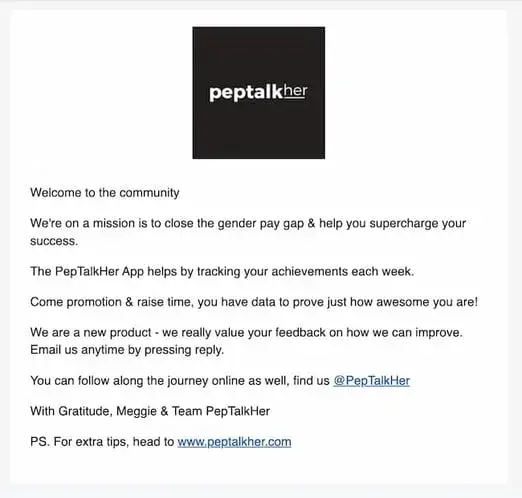
While many subscribers click submit to solve a problem, positivity is key in a welcome email. This org supports women on their path to wage equality.
It could be tempting for this email to start with emotionally charged language or statistics that show how big a problem the gender pay gap is.
Instead, PepTalkHer shows its understanding of its target audience. This email centers on the support, value, and overall awesomeness of the community.
It also adds useful links to social media and website channels. This helps jump-start each signup’s journey.
What I like: I think it’s amazing that this email’s priority is placed on the benefits it brings to the reader. This creates a sense of belonging and encourages long-term engagement.
2. Swipe Files
Type of Welcome: New Customers
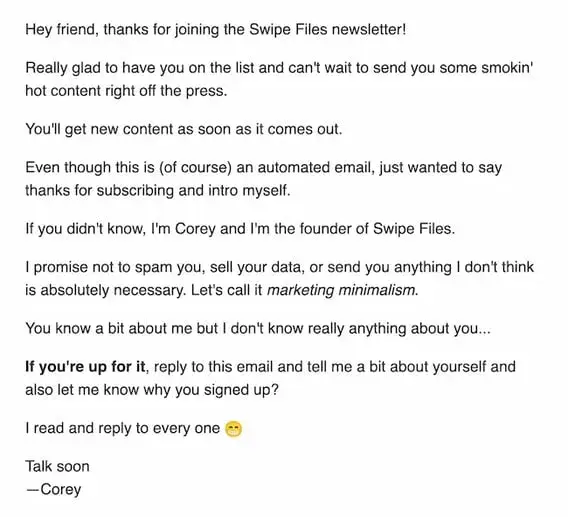
There’s nothing quite like a personal welcome email to make an impression on new subscribers. I believe that good writing is good thinking, and this welcome email is a great example of that idea.
This message reads authentic, kind, and curious. It uses direct language, easy-to-read paragraphs, and simple CTAs. This shows every subscriber what they’re getting into with their subscription and leaves them excited for more.
What I like: This email is more of a personal letter from the founder and less of a welcome email. That’s what makes it stand out and appealing to the reader.
3. Oui the People
Type of Welcome: Discount Code
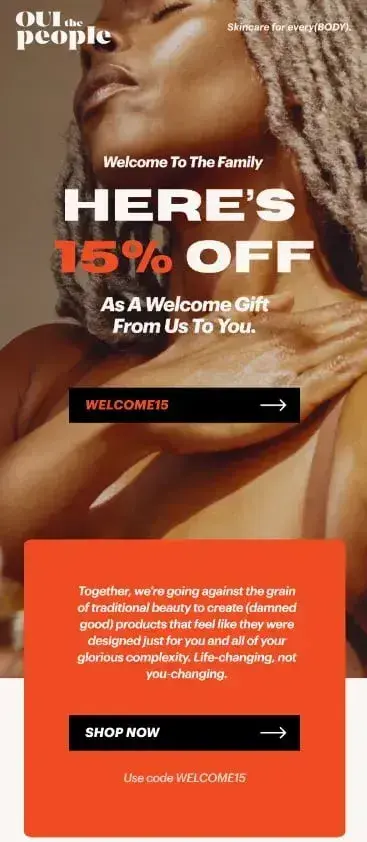
I think powerful graphics are a great way to make a strong first impression.
After signing up for skincare brand Oui the People’s mailing list, the welcome email that hits your inbox makes a gorgeous visual statement that shows the brand’s vision and personality. Then, it uses bold type to make a compelling offer.
The copy that follows not only matches but amplifies the vibe of the opening image.
“Together, we’re going against the grain of traditional beauty to create (damned good) products that feel like they were designed just for you and all of your glorious complexity. Life-changing, not you-changing.”
The one-two punch of graphics, CTA, and copy makes this welcome email difficult not to engage with.
What I like: I love how the powerful and poetic copy perfectly complements the email’s visuals, reinforcing the brand’s unique vision and values.
4. Monday.com
Type of Welcome: Video

From the subject line down to the conversational tone in the email body, the welcome email above keeps it friendly and simple, so the focus stays on the introductory video inside.
Monday.com is a task management tool for teams and businesses. The welcome email you receive when you sign up makes you feel like a CEO because Roy Man is speaking directly to you.
What I like: I love how the email even personalizes the opening greeting by using the recipient’s first name, which is well known for increasing email click-through rates (especially if the name is in the subject line).
In my experience, the more you can make your email sound like a one-on-one conversation between you and your subscriber, the better.
If you have just so many details that you need to inform your new customer about, follow Monday.com’s lead and embed a video rather than spelling them all out in the email itself.
5. Kate Spade
Type of Welcome: Thank You
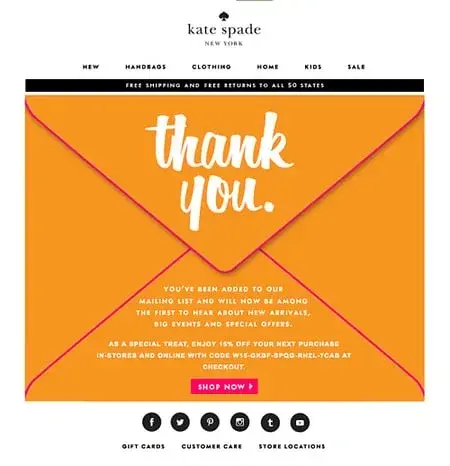
Let’s face it: The internet-using public is constantly bombarded with prompts to sign up for and subscribe to all sorts of email communications.
So, as a brand, when someone takes the time to sift through all the chaos to intentionally sign up for your email communications, it’s a big deal.
To acknowledge how grateful they are to the folks who actually take their time to subscribe, Kate Spade uses a simple but effective tactic with their welcome emails. They say “Thank You” in big, bold lettering.
What I like: To be honest, I am a big fan of what this email looks like. The envelope graphic — which virtually simulates the joy of receiving a physical thank you note — is a nifty and visually appealing way to draw attention to the email.
6. Munk Pank
Type of Welcome: About Us
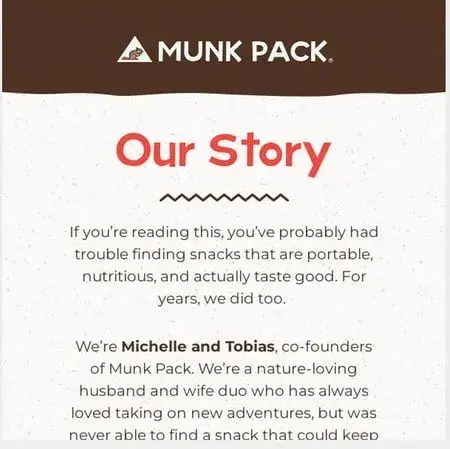
Munk Pank’s welcome email is the story of why the company was founded. This is a healthy snack store founded by a husband and wife.
In their welcome email, they mention that they started the company because they never seemed to find nutritious snacks to keep them energized and on the go.
In my opinion, this is an excellent version of a welcome email. The brand lets its customers know they can relate to the problems they’re facing and that they’ve been there. This helps in building trust and relatability.
It also gives customers a peek into what they should expect from their products.
The email ends by sharing the company’s mission to help them live a healthy lifestyle.
I also like how this welcome email lets subscribers know that they’re joining a tribe that is concerned about their healthy eating and lifestyle, a mission that goes beyond snacks.
What I like: A personal message from the founder gives the product a face and acknowledges the brand’s dedication to making people’s lives healthier.
7. Who Gives a Crap
Type of Welcome: Product Story
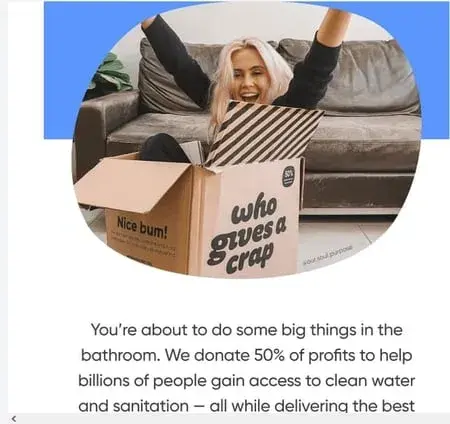
Who Gives a Crap is an organization that sells organic toilet paper, and they’re passionate about it. I found their welcome email to be equally fun and informative.
They state all the reasons why you should opt for organic and eco-friendly products. Then, they sweeten the pot (pun intended) by noting that they donate 50% of their profits to global sanitation projects.
The email reminds the buyer that they still get the toilet paper at the same price they do in the supermarket. It also has a compelling CTA in its welcome email: 10% off its products for people who subscribe to its email list.
The company added its “Shop Now” button for convenience, so if readers are convinced to buy, they can do so in one click.
What I like: I like that the email is written entirely in a playful tone while the message is extremely clear about the company’s nature-friendly principle and donation policy.
This creates a message that is both fun and informative, and it becomes something that someone will remember for a long time if it is their first experience with the business.
8. SAXX Underwear
Type of Welcome: Free Gift or Offer
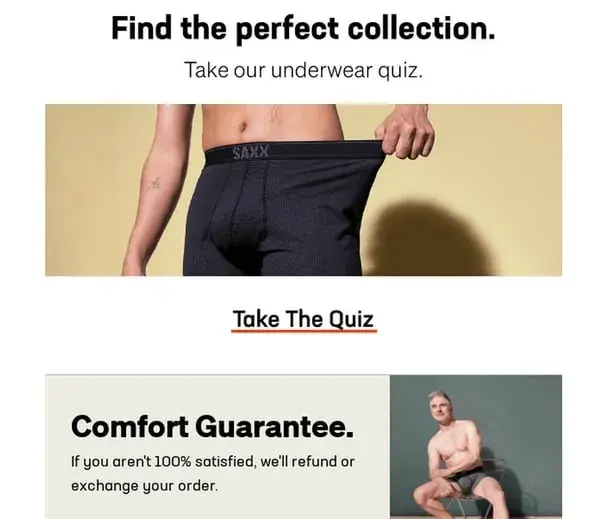
SAXX Underwear specializes in men’s underwear, and its welcome email is very catchy and creative.
The subject line, “Welcome to you and your balls,” is just a taste of how the company uses a humorous and relatable tone to connect with its audience.
Their welcome email is visual, too. It demonstrates their comfort guarantee with images of models wearing their boxers. The welcome email also gives a 10% off code for first-time buyers and directs them to their store.
To me, what really stands out in the SAXX Underwear welcome email is the tone of the copy and the careful yet bold and catchy choice of words.
What I like: I’m impressed by the sincerity of the brand in the first email when it presents the refund policy.
Knowing that they can return the product very easily if they are not fully satisfied with the brand’s items makes the customers who are choosing a product for the first time feel more confident, and as a result, they might try the products.
9. InVision
Type of Welcome: Product Demo
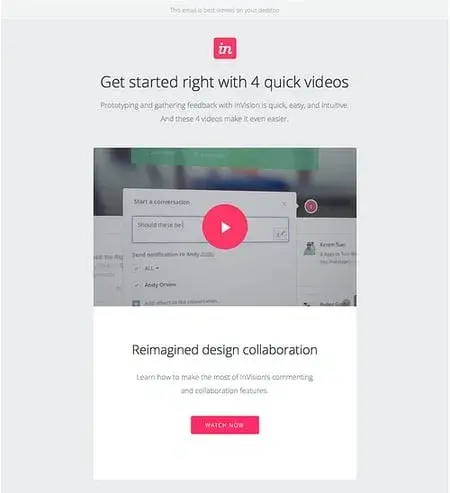
When you sign up for InVision’s free prototyping app, the welcome email makes your next step very clear.
To guide people on how to use InVision’s app, the company’s welcome email doesn’t simply list out what you need to do to get started. Instead, it shows you what you need to do with a series of quick videos.
Given the visual, interactive nature of the product, this makes a lot of sense.
What I like: I find this welcome email particularly helpful. In fact, it offers a step-by-step guide to further interactions. This highlights the user-friendliness that the company provides, along with the smooth onboarding process.
10. Inbound
Type of Welcome: Event Signup
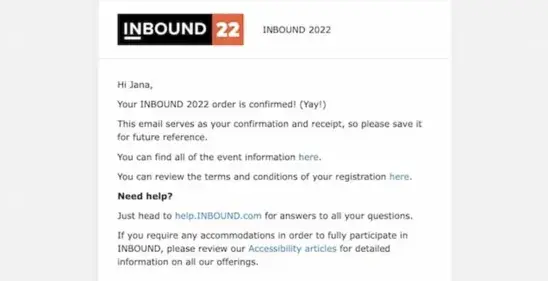
Inbound attracts business professionals from all over the world. I believe that is the reason why its event confirmation email is simple and easy to follow, with useful links for event information, help, and accessibility.
Keep scrolling, and you’ll see even more useful additions, like:
- Links to add the event to your calendar.
- Social media sharing buttons.
- Directions through Google Maps.
What I like: I like how this all-in-one approach of the welcome email ensures that even if people who wish to attend only see one email, it will include everything they need.
11. Creative Capital
Type of Welcome: New Donor
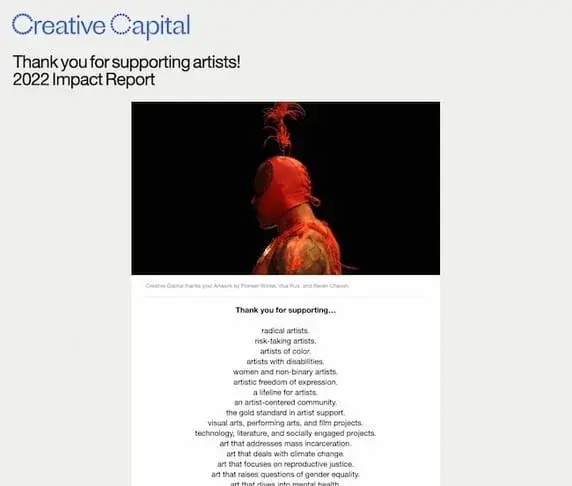
Nonprofit marketing can be a challenge, but this email sheds light on endless possibilities. In this welcome email, donors to Creative Capital get a healthy dose of inspiration.
The email begins with a striking GIF that combines the work of supported artists with bright thank-you messages. It continues with a poetic message about the types of artists the org supports.
This is a chance to inspire every donor. It reminds them who their donation is supporting and why that action has massive value.
What I like: I really like how the animated GIF at the email’s beginning does all that to catch the attention and set the tone for the rest of the message.
12. Baltic Born
Type of Welcome: Customer Loyalty
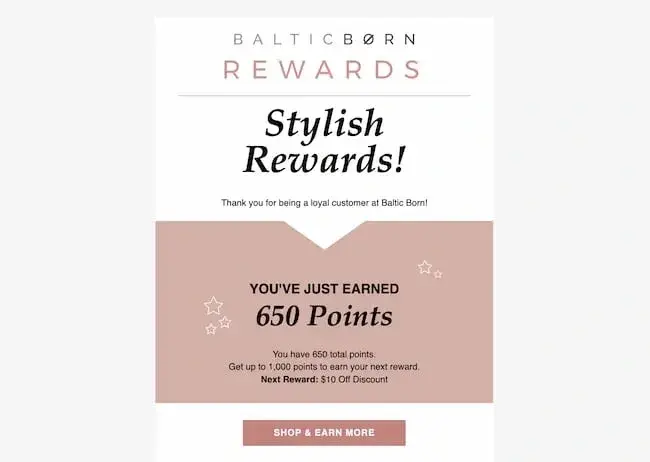
Frequent shoppers can end up in more loyalty programs than they can count, so it’s important for these welcome emails to stand out and show off a big offer.
From the start, this email focuses on concrete rewards. Then, it gives a clear explanation of Baltic Born’s reward system. It continues with a button that compels the recipient to get more points.
And, the monochromatic design is attractive but not distracting or overwhelming, making it easy to read on mobile devices.
What I like: The effective part of the email is that it tells everything about the loyalty program in a straightforward way and gives easy guidelines on how to get the points.
This makes it easy for me to engage with the brand and feel rewarded for my loyalty.
Welcome Email Templates
Need help getting your welcome email efforts off the ground? I’ve got you covered with free welcome message templates that streamline the connection process.
Each template shows a different way you can welcome your customers. These examples make it simple to send a welcome email to meet your customers’ needs at their current spot in the customer journey.
1. About Us
An About Us welcome email introduces new subscribers to your company with a firsthand story. It gives you a chance to share who you are, what you do, and what you stand for.
This helps you develop a relationship with your subscribers, which can help them feel more invested in your brand.
I strongly believe that this is also a chance to set the right expectations about the content or benefits you offer to your subscribers.
Hey [First name],
Welcome to [Brand name]. We’re thrilled to have you join us on our mission to [insert company mission or vision].
We started [Brand name] to solve [insert the problem your product or service solves] because [creation story for your founder(s)]. We want to inspire people to [insert big-picture product impact].
We are constantly refining our product to live up to our vision.
We believe that [our product] will make a difference for you too, and we can’t wait to hear your story. Please feel free to reply to this email and tell us about you and what you hope to achieve.
Thank you for joining us on this journey. We look forward to hearing your story.
Looking forward to hearing more,
[Signature]
2. Product Story
Product story emails showcase your product or service and give you a chance to educate and inspire with your welcome. A product story welcome email doesn’t just have to be about how you created your product. It can tell stories about:
- The problem your product or service solves.
- Product benefits.
- The materials you use to make your product.
- Key product features.
This welcome email can help you expand brand awareness as well as improve customer engagement and conversions.
3. Video
Video welcomes are a quick and powerful way to connect with new customers, subscribers, or employees. You can feature the people, culture, or messaging that represent your brand in your video. Videos are also a great way to share:
- Product features and benefits.
- Tutorials.
- Promotions.
Video welcome emails can help your business stand out from companies sending text-only email communication. They’re also a quick way to grab attention as you begin your relationship with a new contact.
Welcome to [Brand name], [first name of your subscriber].
We’re excited to share this video message [insert link to the video]. It will tell you a little bit about [content of your video].
Watching this quick video is just the first step toward reaching your goal of [desired outcomes for contact]. Our team is always here to offer you the guidance and resources you need.
Thank you for being a part of the [Brand name] community.
[Signature]
4. Free Gift or Offer
Free gifts and welcome offers give new subscribers and customers a tempting reason to engage with your brand. I think they can be very useful for creating urgency.
These welcome emails are also a great way to highlight personalized offers for the latest addition to your email list.
A free offer or exclusive gift can improve customer retention and loyalty, as well as build anticipation for future offers.
Hey [First name] —
Welcome to [Brand name]!
As the latest (and greatest) addition to our community, we’d like to give you a free [insert gift item]. It’s our way of saying thank you for choosing us for your [product type] needs.
To claim your [offer], just add the promo code FREEGIFT at checkout, and your gift will be on the way to you soon.
If you have any questions or feedback before then, please get in touch at [contact information]. We’re always here to help.
All best,
[Signature or Brand name]
5. Event Signup
An event signup welcome email is key to the event registration process. This one piece of communication:
- Confirms successful event registration.
- Offers important event logistics.
- Highlights speakers and other event details.
- Prepares attendees for the event.
This type of welcome email is also a first step to connecting with a customer. It builds trust and shows how they can benefit from further engagement.
Hi [Attendee name],
Thank you for registering for [Event name]. We can’t wait for you to join us during this important event.
This email includes your registration confirmation, event location, date, and more.
- [Registration Confirmation Details]
- [Attendee name]
- [Attendee email]
- [Registration type (such as VIP, General Admission, etc.)]
- [Number of tickets]
- [Confirmation code]
- [Event name]
- [Event location]
- [Date and time]
This session will include [featured panels, speakers, sessions]. We’ve also organized [meeting rooms, mixers] for networking opportunities and connecting with your peers.
You’ll also have the chance to see [special events, attendee-only exclusives].
Note: You’ll need your confirmation code or badge to enter the event, and we’ve attached a PDF with other helpful tips.
If you have any questions about your registration, contact [Event organizer] or respond to this email.
Thank you again for registering for [Event name]. We can’t wait to see you there!
Best regards,
[Signature]
6. Confirmation
Confirmation emails can sometimes feel cold or impersonal, so this is another email where it’s vital to add some welcome. A confirmation email assures your subscriber or buyer that they’ve successfully completed the signup.
It’s also a chance to share useful information to make them feel more comfortable about what comes next.
For example, you might want to add order details, shipping, or the day of the week your newsletter comes out.
Based on my understanding of customer experience, personalizing this welcome email can go a long way toward building trust with your subscribers.
Hi [First name],
Thank you for your [subscription] to [Newsletter or Brand name]!
There’s just one more step to complete the process and join [Brand name’s] community of [term that describes your customers, such as business owners, rock stars, nature lovers]. Click the link below to confirm your subscription.
With that one click, you’ll be the first to know the latest updates, products, and resources from us. You’ll also have access to quality content and support.
Thank you again for subscribing. We can’t wait to share and learn with you.
[Signature]
7. Free Trial
Your welcome email for a free trial is important because it sets the tone for your relationship with each customer. I feel this is a chance for you to say thank you, offer extra help, and set expectations for your product.
This first email is also a chance to show users how to make the most of your product and point out features and benefits they might miss on their own.
This welcome email has a specific goal — to turn that free trial into a paying customer. With that in mind, it’s important to strike a balance. This email should point out tips, features, and details but not overwhelm with too much information.
Hi [First name]!
Thank you for signing up for your free trial of [product or Company name]. We can’t wait for you to try out our [product].
With your free trial, you’ll have access to [popular features] so you can test what works for you. To make the most of your free trial, [outline the first step], then [list two or three potential use cases].
If you’re looking for support or instructions, check out [links to support, help, and social media resources]. You can also take a quick look at the product video below for a quick walk-through.
We’ll be in touch with next steps for your trial soon. Until then, thank you again for choosing [product or brand name]!
Hoping this is helpful,
[Signature]
8. Thank You
Thank you welcome emails lead with gratitude to your subscribers and customers. Whether they’re signing up for your newsletter, RSVPing for an event, or making a purchase, this welcome email leads with the positive.
Hi [First name],
Thank you for choosing [Brand name]. We’re so happy you decided to [join, subscribe, complete a purchase].
Giving you a great experience is our top priority — and on that note, we want to make sure you know that our [Customer loyalty team, customer support team, social media community] is here with news, offers, and more just for you.
Again, thank you for choosing [Brand name]. We look forward to offering you quality products and winning service for many years to come.
All best,
[Signature]
9. Welcome Email Template for New Customers
Your new customer welcome email often marks the beginning of the customer relationship. This email usually contains a lot of information. It might include order confirmation, product information, helpful tips, or a review request.
At the same time, I believe it needs to set a tone that emphasizes the character and value of your brand and products. So, it needs to be welcoming, engaging, and encouraging.
Hi [Customer],
This is really exciting: Welcome (officially) to [your product or service here]. We’re so lucky to have you.
[I/we] are here to help make sure you get the results you expect from [your product or service], so don’t hesitate to reach out with questions. [I’d/we’d] love to hear from you.
To help you get started, [I/we] recommend checking out these resources:
- [Resource 1]
- [Resource 2]
- [Resource 3]
If you need support, you can reply to this email or give us a call at [555-555-5555]. [I/we] can talk you through the details and information you need to get started.
Looking forward to hearing from you,
[Your company/name]
10. Discount Code
In my experience, discount codes always make great welcome emails. This is because they lead with something your subscriber wants.
It encourages a purchase, but this email is also a chance to show appreciation, develop brand awareness, or boost new products.
To make the most of these emails, I always try to add limited-time or occasion-specific offers. This adds urgency and gives you a chance to quickly boost your customer relationship.
[First name],
You don’t have to wait to experience [popular products]. As a welcome to our community, we’re offering you a special discount.
To use your discount, just enter the code WELCOME10 when you check out. You can use this code to purchase [specific products or special promotion].
One more thing: Be sure to take advantage of this offer before [expiration date].
If you need any help or guidance using your discount code, just get in touch with [support team information.]
Thank you!
[Signature]
11. Customer Loyalty
Some customers will get more than one welcome email from you, so it’s important to make your welcome email specific.
One example is your customer loyalty program. When someone signs up to be an affiliate or joins an incentive program for your brand, they need a different kind of welcome.
As you draft this email, focus on personalized connection. Whether you’re offering thanks for their support, sharing sneak peeks, or giving exclusive offers, each customer needs to feel special.
Use surveys, interactive features, and integrations to collect feedback from current customers. Then, once your subscribers become loyal customers, you can use these tools to make your loyalty welcome email super personal.
Hey [First name],
Welcome to [Brand loyalty program]! You’ve joined an exclusive group of customers who make our brand and products better, and we are so excited you’re here.
Customer loyalty at [Brand name] means [outline top loyalty program benefits]. It’s a personal thank you for choosing our products.
Your membership also includes these perks:
- [Benefit 1]
- [Benefit 2]
- [Benefit 3]
To make the most of your benefits, [share first steps to activate membership].
We also want to hear from you! Contact us with any questions or feedback — our team is always here to help.
Your first purchase, [name of first product purchase], set you on the path to becoming one of our most loyal customers. We can’t wait to see what you’ll do as part of our [Loyalty program] community.
Kind regards,
[Signature]
12. New Donor
Each new donor has a major impact on your business’s future. So, the way that you welcome each donor is a key part of their experience.
This welcome email is a chance to offer thanks, review your company’s mission and vision, or ask for continued or deeper engagement. The donor welcome email is also a time to:
- Share inspirational stories.
- Highlight the problems your organization is working to solve.
- Offer recent data on the status of your work.
Dear [Donor name],
I’m writing to personally welcome you to [Nonprofit Organization name]. Thank you again for your generous donation.
Your contribution is making an immediate impact on our work to [revisit your mission and/or vision].
With your support, our team will continue to [outline important services and impact]. With continued work together, we can make a lasting difference.
We will stay in touch with updates and events at [Nonprofit Organization name]. We’ll also share critical updates on how your contribution is improving [share recent data and statistics toward critical goals].
Thank you again for your donation and for choosing to be a part of [Nonprofit Organization name]’s vision.
Best regards,
[Signature]
Now that you’ve seen some great examples of welcome emails and templates, let’s dig into the process of writing a great email and catching customer attention.
How to Write a Welcome Email: Step-by-Step
1. Make the “From Name” recognizable and personal.
Who your email is from might matter more than what it says. If your subscriber doesn’t recognize the name in their inbox, they’re more likely to ignore it — or worse, mark it as spam. Keep it familiar and human. If you’re a solopreneur, your first name might be enough. If you’re a brand, consider a hybrid. “Jeanne Jennings, Email Optimization Shop” strikes the balance between personal and professional.
Pro tip: Whatever you choose, be consistent. The inbox is no place for identity crises.
2. Craft an engaging subject line + preheader text.
The welcome email begins before your subscriber opens it. Your subject line and preheader text are the red carpet moment — and you want to give them a reason to not just open but click.
Avoid sounding like a robot (“Welcome to Our Newsletter”) or an apology (“Thanks, I guess”). Instead, try something a little more human: “You’re in. Let’s make email magic.” Pair that with a preheader like “What to expect — and one quick thing to do next.”
Example:
Subject line: “Glad you’re here, let’s get started.”
Preheader: “Peek at what’s coming (and how to make the most of it).”
3. Write a warm, on‑brand greeting.
Now’s not the time for “Dear Valued Subscriber.” Use their first name if you have it, and speak like a person. If your brand voice is upbeat and chatty, lead with enthusiasm. If it’s calm and informative, keep it warm but grounded. And skip the “on behalf of the team” stuff. Just talk to the reader, one-to-one.
Example:
“Hi Kyle,
I’m so glad you’re here. You just joined a smart group of folks who want to get more strategic (and frankly, more fun) with their email marketing. Let’s get started.”
4. Express gratitude and remind them why they signed up.
Gratitude goes a long way. A simple “thanks for joining” creates a positive tone, but go one step further by reminding them why they’re here. Reaffirm their decision. If they signed up for a checklist, mention it. If they subscribed out of curiosity, give them a preview of what’s to come.
Anchor the moment in their motivation, not your brand agenda.
Example:
“Thanks for signing up to get smarter about your email program. Whether you’re here for strategy, inspiration, or the occasional subject line rant, I’ve got you covered.”
5. Deliver immediate value.
The inbox is a competitive place, especially for a newcomer. Your welcome email should offer a clear win right away. That could be a resource (“Download Your Welcome Series Planner”), a recommendation (“Here are 3 popular posts to start with”), or even a surprising tip. This shows your emails aren’t just filler. They’re useful, timely, and worth their spot in the inbox.
Example:
“Here’s a subscriber-only worksheet to map your next three campaigns. Grab it here.”
6. Set expectations for what’s next.
Let your subscriber know what kind of content you’ll send, how often, and when. Setting expectations up front not only builds trust, it also keeps your list clean by deterring folks who might otherwise be surprised and unsubscribe at the first campaign. This can be a quick bullet list or a sentence or two.
Example:
“You’ll hear from me about once a week, usually on Tuesdays. Expect strategy tips, campaign breakdowns, and occasional deep dives into subject lines that should have stayed in draft.”
7. Include one clear, bulletproof CTA.
Don’t bury your ask in a pile of links. Decide what the next best action is for your reader, then build your email around that. And make sure your button is bulletproof: styled with HTML, not dependent on images, and clear even if the pictures don’t load.
Your CTA should answer this question: What should I do next?
Example:
“Download Your Campaign Planner”
“Browse Our Favorite Resources”
“Tell Me Your Email Goals”
8. Add a touch of social proof or storytelling.
People trust people. A short testimonial, a sentence about your brand’s origin, or a quote from a happy customer can humanize your message and reinforce credibility. This isn’t about overselling; it’s about showing that your email list is a trusted place to be.
Example:
“This list includes everyone from solo entrepreneurs to email directors at Fortune 500s, folks who want better results without gimmicks. You’re in good company.”
9. Sign off like a human (and invite them to stay connected).
Don’t ghost at the end. Wrap up with a warm sign-off and leave the door open for conversation or connection. If appropriate, invite them to follow you on social or reply with a question. This reinforces that this isn’t a one-way blast — it’s the beginning of a relationship.
Example:
“Glad to have you here. If you want to say hi, or tell me what you’re working on, just hit reply. I read every one. Be safe, stay well, Jeanne.”
How to Write an Employee Onboarding Welcome Email: Step-by-Step
Welcome emails aren’t just for customers. The onboarding process has a huge impact on how new employees feel about your company, so it’s important to give it the time and energy it deserves.
One of the important parts of this process is the onboarding welcome email. It has to match the company’s tone and outline all the expectations you have for the new employee.
Here are the steps that I follow when writing an onboarding email.
1. Start with a warm, human subject line.
This isn’t just an announcement — it’s a personal moment. Your subject line should reflect that. Skip the sterile stuff (“Welcome to the Company”) and try something a little more you.
Think:
“We’re so glad you’re here!”
“Welcome to Team [Company Name], Jamie!”
“Big day. Big welcome. Let’s do this.”
This is one of those rare cases where exclamation points are completely acceptable.
2. Make the “From Name” friendly and recognizable.
The email should come from someone the new hire will actually interact with, like their manager, team lead, or even the CEO if the org is small enough. “HR Department” sounds like paperwork. “Natalie from Marketing” sounds like a person who’s excited to meet them. Bonus points if their manager or buddy also sends a follow-up note later that day.
3. Open with enthusiasm and personalization.
A welcome email should sound like a welcome message, not a copy-paste. Use their name. Reference their role. Show that you know who they are, not just what position they’re filling. If possible, include a line about why they’re a great fit or what the team’s looking forward to.
Example:
“Hi Alex —
We’re so excited you’re officially part of the team! Your experience with user-centered design is going to make a huge impact here, and I know the product team can’t wait to dive in with you.”
4. Reinforce culture and values early.
The welcome email is a prime opportunity to introduce (or reinforce) your company culture. Not with a five-paragraph mission statement, but with a short, genuine expression of what matters around here.
Are you big on collaboration? Do you celebrate learning? This is your moment to set that tone.
Example:
“Around here, we value curiosity, collaboration, and GIFs in Slack. You’ll see what we mean soon.”
5. Outline what happens next (without overwhelming them).
Let them know what to expect on Day 1 or Week 1. You don’t need to attach the whole onboarding manual (please don’t), but a simple bullet list or short paragraph helps reduce anxiety and sets clear expectations.
Example:
“Here’s what your first day will look like:
- Quick check-in with your manager at 9:30.
- Team welcome coffee (virtual or IRL) at 10:15.
- IT will help get your setup finalized by noon.
We’ll walk you through everything, so no pressure to memorize this.”
6. Link to useful resources or prep materials.
If there’s anything they need to read, fill out, or review ahead of time, make it easy to find. Avoid dumping six links with zero context. Instead, frame it as “Here’s what’s most helpful to look at before Day 1.” And please, no passive-aggressive all-caps PDFs like “MANDATORY POLICY 2021_FINAL_FINAL2.”
Example:
“If you want a head start, here are two quick reads:
- Our Culture Deck (fun, I promise).
- Your onboarding checklist (we’ll review this together Monday).”
7. Invite questions (and actually mean it).
Starting a new job can be nerve-wracking, even in the best orgs. Let them know who they can reach out to and that no question is too small. Make it clear you want them to ask now, not suffer silently later.
Example:
“If anything’s unclear, or even if you’re wondering what to wear Monday, reply here. There are no wrong questions. We’ve all been the new kid.”
8. Close with excitement and real people energy.
Wrap it up with warmth. Sign off like a person, not a department. Even if this is the first in a series of onboarding messages, this one should feel personal and upbeat.
Example:
“Can’t wait to see all you’ll do here. Enjoy the weekend. Monday’s going to be a great start.
— Casey (and all of Team Design)”
Make a great first impression.
So here’s my challenge to you: Don’t waste the welcome. Don’t treat it like just another transactional message or onboarding task to check off. Whether you’re speaking to someone who just joined your email list or someone about to walk into your office (or Slack channel), that first email matters more than you think.
Write it like you mean it. Lead with real value, not a sales pitch or a policy doc. Be clear about what’s coming next. And most importantly, let your human voice come through. You’ve already earned their initial trust: that click, that signature, that “yes.” Now’s your chance to build on it.
You only get one “first email.” Make it count.
Editor's note: This post was originally published in August 2024 and has been updated for comprehensiveness.
Email Examples
.png?width=112&height=112&name=Image%20Hackathon%20%E2%80%93%20Vertical%20(67).png)

.png)
.webp)
![4 types of emails that get the most engagement [+ 4 emails that fail]](https://53.fs1.hubspotusercontent-na1.net/hubfs/53/Untitled%20design%20(56).jpg)






